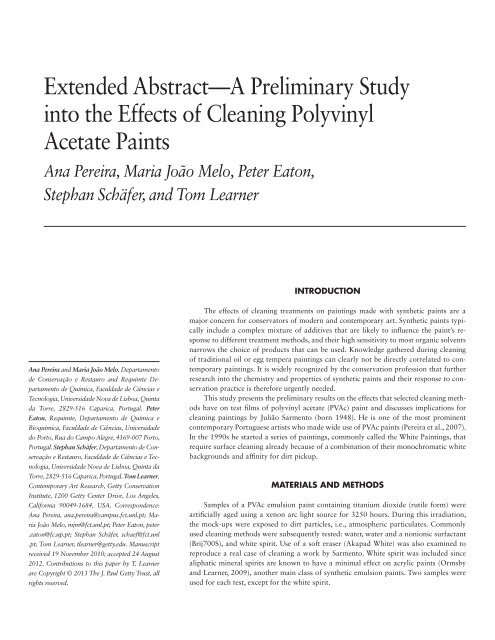You also want an ePaper? Increase the reach of your titles
YUMPU automatically turns print PDFs into web optimized ePapers that Google loves.
Extended Abstract—A Preliminary Study<br />
<strong>into</strong> <strong>the</strong> Effects <strong>of</strong> <strong>Cleaning</strong> Polyvinyl<br />
Acetate Paints<br />
Ana Pereira, Maria João Melo, Peter Eaton,<br />
Stephan Schäfer, and Tom Learner<br />
INTRODUCTION<br />
Ana Pereira and Maria João Melo, Departamento<br />
de Conservação e Restauro and Requimte Departamento<br />
de Química, Faculdade de Ciências e<br />
Tecnologia, Universidade Nova de Lisboa, Quinta<br />
da Torre, 2829-516 Caparica, Portugal. Peter<br />
Eaton, Requimte, Departamento de Química e<br />
Bioquímica, Faculdade de Ciências, Universidade<br />
do Porto, Rua do Campo Alegre, 4169-007 Porto,<br />
Portugal. Stephan Schäfer, Departamento de Conservação<br />
e Restauro, Faculdade de Ciências e Tecnologia,<br />
Universidade Nova de Lisboa, Quinta da<br />
Torre, 2829-516 Caparica, Portugal. Tom Learner,<br />
Contemporary Art Research, Getty Conservation<br />
Institute, 1200 Getty Center Drive, Los Angeles,<br />
California 90049- 1684, USA. Correspondence:<br />
Ana Pereira, ana.pereira@campus.fct.unl.pt; Maria<br />
João Melo, mjm@fct.unl.pt; Peter Eaton, peter<br />
.eaton@fc.up.pt; Stephan Schäfer, schaef@fct.unl<br />
.pt; Tom Learner, tlearner@getty.edu. Manuscript<br />
received 19 November 2010; accepted 24 August<br />
2012. Contributions to this paper by T. Learner<br />
are Copyright © 2013 The J. Paul Getty Trust, all<br />
rights reserved.<br />
The effects <strong>of</strong> cleaning treatments on paintings made with syn<strong>the</strong>tic paints are a<br />
major concern for conservators <strong>of</strong> modern and contemporary art. Syn<strong>the</strong>tic paints typically<br />
include a complex mixture <strong>of</strong> additives that are likely to influence <strong>the</strong> paint’s response<br />
to different treatment methods, and <strong>the</strong>ir high sensitivity to most organic solvents<br />
narrows <strong>the</strong> choice <strong>of</strong> products that can be used. Knowledge ga<strong>the</strong>red during cleaning<br />
<strong>of</strong> traditional oil or egg tempera paintings can clearly not be directly correlated to contemporary<br />
paintings. It is widely recognized by <strong>the</strong> conservation pr<strong>of</strong>ession that fur<strong>the</strong>r<br />
research <strong>into</strong> <strong>the</strong> chemistry and properties <strong>of</strong> syn<strong>the</strong>tic paints and <strong>the</strong>ir response to conservation<br />
practice is <strong>the</strong>refore urgently needed.<br />
This study presents <strong>the</strong> preliminary results on <strong>the</strong> effects that selected cleaning methods<br />
have on test films <strong>of</strong> polyvinyl acetate (PVAc) paint and discusses implications for<br />
cleaning paintings by Julião Sarmento (born 1948). He is one <strong>of</strong> <strong>the</strong> most prominent<br />
contemporary Portuguese artists who made wide use <strong>of</strong> PVAc paints (Pereira et al., 2007).<br />
In <strong>the</strong> 1990s he started a series <strong>of</strong> paintings, commonly called <strong>the</strong> White <strong>Paintings</strong>, that<br />
require surface cleaning already because <strong>of</strong> a combination <strong>of</strong> <strong>the</strong>ir monochromatic white<br />
backgrounds and affinity for dirt pickup.<br />
MATERIALS AND METHODS<br />
Samples <strong>of</strong> a PVAc emulsion paint containing titanium dioxide (rutile form) were<br />
artificially aged using a xenon arc light source for 3250 hours. During this irradiation,<br />
<strong>the</strong> mock- ups were exposed to dirt particles, i.e., atmospheric particulates. Commonly<br />
used cleaning methods were subsequently tested: water, water and a nonionic surfactant<br />
(Brij700S), and white spirit. Use <strong>of</strong> a s<strong>of</strong>t eraser (Akapad White) was also examined to<br />
reproduce a real case <strong>of</strong> cleaning a work by Sarmento. White spirit was included since<br />
aliphatic mineral spirits are known to have a minimal effect on acrylic paints (Ormsby<br />
and Learner, 2009), ano<strong>the</strong>r main class <strong>of</strong> syn<strong>the</strong>tic emulsion paints. Two samples were<br />
used for each test, except for <strong>the</strong> white spirit.
















